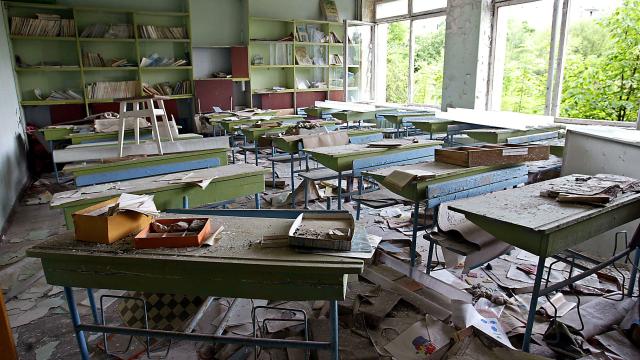Two new papers out Thursday highlight the aftereffects of the Chernobyl nuclear accident that occurred over 30 years ago. One study might help explain why survivors are more likely to develop thyroid cancer, while another found evidence that these survivors don’t seem to have passed on potentially harmful mutations to their children.
The 1986 accident at the Chernobyl Nuclear Power Plant, located near the city of Pripyat in what’s now Ukraine, is still considered one of the worst disasters of its kind. A botched safety test resulted in two large explosions that ruptured the core of Reactor 4 and destroyed part of the surrounding building. The destruction caused massive fires and released significant radioactive contamination into the air and environment.
The fires killed two people, while the radiation exposure was severe enough to kill an estimated 28 more plant workers and firefighters in the months after the accident. More than 100 other people suffered acute radiation sickness, and it’s estimated that over 8 million people, including 200,000 people involved in the clean-up effort, were ultimately exposed to higher than usual doses of radiation. The land surrounding Chernobyl is still highly radioactive. More recently, wildfires near the site raised the risk that lingering radiation could be made airborne again.
The only clear link between the accident and longer-term health problems in those living nearby has been thyroid cancer, particularly in children. Between 1991 and 2015, there were around 20,000 thyroid cancer cases documented among people who were under the age of 18 at the time of the accident. And a study in 2018 conducted by the United Nations estimated that one of every four of these cases could “probably” be attributed to radiation exposure.
The new studies, both published in Science, each looked at a different aspect of the accident and its potential harms.
One study analysed nearly 400 survivors in Ukraine who had developed thyroid cancer likely linked to Chernobyl and compared them to cancer patients in the country who were unexposed to the accident, since they were born afterward. With the help of blood and tumour samples, they sequenced the genomes of these patients. They also measured levels of gene expression and possible changes to that gene expression that might have been related to the radiation, otherwise known as a person’s epigenetics.
The team ultimately found a possible dose effect, where higher doses of radiation during the accident at a younger age were associated with more breaks of both DNA strands in the tumours people developed. These double-stranded DNA breaks were also linked to possibly harmful mutations known as gene fusions, where the strands break and then fuse back together incorrectly. But the thyroid cancers in those unaffected by radiation were more likely to be caused by point mutations, where a single key change in a gene leads to tumour growth. The findings could represent a unique characteristic of radiation-induced cancers, one that might help doctors someday distinguish them from other cancers.
The other study, meanwhile, analysed the genetics of children born to Chernobyl survivors. They specifically looked for de novo, or germline, mutations — mutations that arise in the sperm or egg of a parent that can be passed down to offspring. But when compared to children born to unexposed parents, the researchers found no increase in de novo mutations among the children of survivors.
The findings, according to the authors, should be a relief for people worried about the impacts of other recent nuclear accidents on future generations, such as the 2011 Fukushima accident in Japan.
“We view these results as very reassuring for people who were living in Fukushima at the time of the accident in 2011,” said study author Stephen Chanock, director of the National Cancer Institute’s Division of Cancer Epidemiology and Genetics, in a statement released by the NCI. “The radiation doses in Japan are known to have been lower than those recorded at Chernobyl.”
Both studies should also bring us closer to understanding the health effects of radiation on people.
“In recent years, advances in DNA sequencing technology have enabled us to begin to address some of the important questions, in part through comprehensive genomic analyses carried out in well-designed epidemiological studies,” Chanock said.
